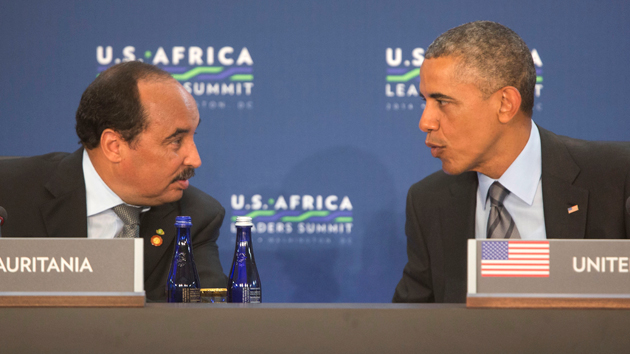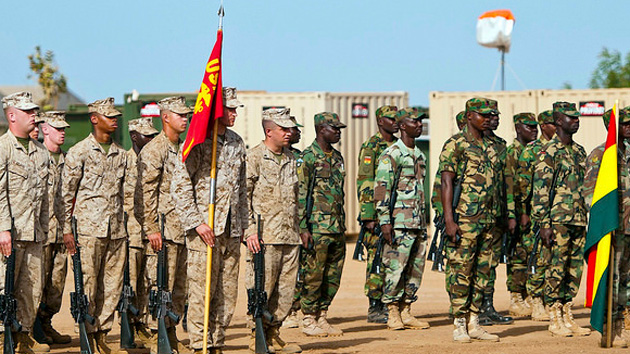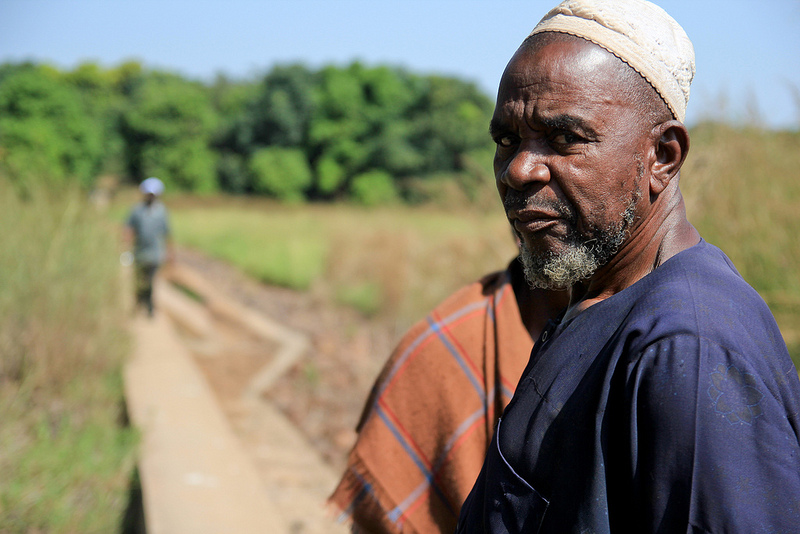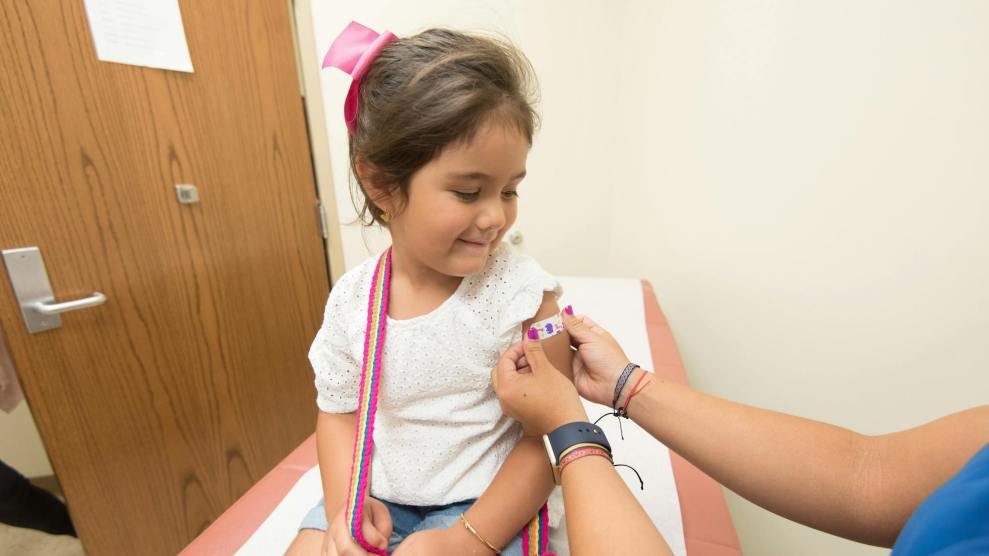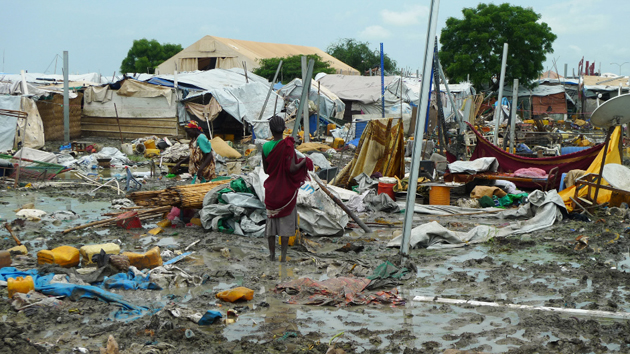
Women walk through the muddy UN Mission in South Sudan camp in Malakal.Nick Turse
This story first appeared on the TomDispatch website.
Out by the swimming pool and the well-stocked bar, every table is packed with people. Slightly bleary-eyed men and sun-kissed women wear Santa hats and decorations in their hair. One festive fellow is dressed as Cousin Eddie from National Lampoon’s Christmas Vacation complete with a white sweater, black dickey, and bright white loafers. Another is straddling an inflatable killer whale that he’s borrowed from the collection of playthings around the pool and is using as improvised chair while he stuffs his face from an all-American smorgasbord. We’re all eating well tonight. Mac and cheese, barbequed ribs, beef tenderloin, fried chicken, mashed potatoes and gravy, green beans, and for desert, peach cobbler. The drinks are flowing, too: wine and whisky and fine Tusker beer.
Yuletide songs drift out into the sultry night in this, the capital of the world’s newest nation. “Simply having a wonderful Christmastime,” croons Paul McCartney.
Just 15 minutes away, near the airport in an area known as Tongping, things aren’t quite so wonderful. There’s no fried chicken, no ribs, no peach cobbler. At Juba’s United Nations camp for internally displaced persons (IDPs), they’re eating sorghum and a crude porridge made from a powdered blend of corn and soy beans provided by the United Nations’ World Food Program. Children at the camp call it “the yellow food.” “It’s no good,” one of them tells me, with a quick head shake for emphasis.
I mention to a few of the embassy revelers that I’m heading several hundred miles north to Malakal. A couple of them assure me that, according to colleagues, it’s “not that bad.” But while we’re chowing down, an emaciated young girl in Malakal clings to life. This one-year-old arrived at the hospital run by Médecins Sans Frontières (Doctors Without Borders, or MSF) at the U.N. camp there several days earlier, severely malnourished and weighing just 11 pounds. It’s uncertain if she’ll survive. One in 10 children who arrive at the hospital in her condition don’t.
A Man-Made Famine
As John Kerry, then-chair of the Senate Foreign Relations Committee, put it in 2012, the United States “helped midwife the birth” of South Sudan. The choice of words may have been cringe-worthy, but hardly divorced from reality. For more than 20 years, a bipartisan coalition in Washington and beyond championed rebel forces here. As the new nation broke away from Sudan, after decades of bloody civil war, the US poured in billions of dollars in aid, including hundreds of millions of dollars of military and security assistance, and sent military instructors to train the country’s armed forces and advisers to mentor government officials.
It would be Washington’s major nation-building effort in Africa, a new country destined to join Iraq and Afghanistan as a regional bulwark of democracy and a shining example of American know-how. On South Sudan’s independence day, July 9, 2011, President Obama hailed the moment as a “time of hope” and pledged US partnership to the new land, emphasizing security and development. There’s precious little evidence of either of these at the U.N. camps and even less in vast areas of the countryside now teetering on the edge of a catastrophic famine.
Since a civil war broke out in December 2013, at least 10,000 South Sudanese have been killed, untold numbers of women and girls have been victims of sexual violence, and atrocities have been committed by all parties to the conflict. As a result, in the eyes of the United Nations, in a world of roiling strife—civil wars, mass killings, hunger, and conflicts from Iraq to Gaza, Ukraine to Libya—South Sudan is, along with the Central African Republic and Syria, one of just three “L3 emergencies,” the world’s most severe, large-scale humanitarian crises. The country has also just displaced Somalia—for six years running the archetypal failed state—atop the Fund for Peace’s 178-nation list of the world’s most fragile nations.
Today, close to 100,000 people are huddled on United Nations military bases around the country, just a fraction of the almost 1.5 million who have been put to flight and are waiting out the war as internal exiles or as refugees in the bordering nations of Uganda, Ethiopia, Kenya, and Sudan. Such massive levels of displacement guarantee another nightmare to come. Since so many subsistence farmers weren’t around to plant their crops, despite fertile ground and sufficient rain, seeds never met soil and food never had a chance to grow.
“At this point in time, because it’s the rainy season, there’s nothing we can do in terms of agriculture,” says Caroline Saint-Mleux, the regional emergency coordinator for East and Central Africa at CARE International. Above us, the sky is darkening as we sit in plastic chairs in the muddy “humanitarian hub,” a grimy ghetto of white tents, nondescript trailers, and makeshift headquarters of aid agencies like the International Committee of the Red Cross and MSF, on the outer edge of the U.N. base at Malakal. Her organization did distribute a limited number of seeds to farmers still on their land earlier in the year, but can do no more. The planting season is long past. “It would be a waste of energy at this point,” she says, resignation in her voice.
Famine “is a very realistic possibility,” Deborah Schein tells me. She’s the coordinator for the United Nations in Upper Nile State, where Malakal is located. Right now, experts are crunching the numbers and debating whether to formally declare a famine. Whether it’s this fall or early next year, aid workers say, it’s definitely coming and the sooner it comes, the more lives can be saved. Recently, U.N. Security Council President Eugène-Richard Gasana called attention to “the catastrophic food insecurity situation.” Already, 3.9 million people—about one in three South Sudanese—face dangerous levels of food insecurity. However, unlike in Ethiopia in the 1980s, where drought led to crop failures that killed one million people, Vanessa Parra, Oxfam America’s press liaison in South Sudan, says this country is facing an “entirely man-made famine.”
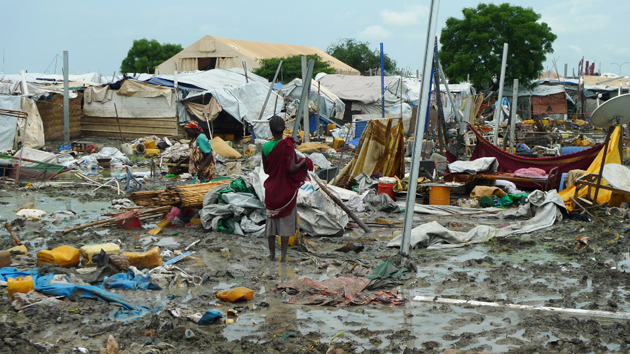
Nyajuma’s Story
If it were dry, it would take only five minutes to walk from Deborah Schein’s office at the U.N. base in Malakal to the Médecins Sans Frontières field hospital in the adjoining IDP camp where 17,000 South Sudanese are now taking refuge. But the rains have turned this ground into fetid mud and an easy walk into a slip-sliding slog.
At the end of a gray, mucky expanse that nearly sucks the boots off your feet, an MSF flag flies outside a barn-sized white tent. Before you enter, you need to visit a foot-washing station, then have your feet or boots disinfected. Even then, it’s impossible to keep the grime out. “As you can imagine, this is not the best environment for a hospital,” says Teresa Sancristoval, the energetic chief of MSF’s emergency operations in Malakal.
Step inside that tent and you’re immediately in a ward that’s electric with activity. It’s hard to believe that this 24-hour-a-day, 7-day-a-week hospital is manned by only three expat doctors and three expat nurses, plus a medical team leader. Still, add in various support personnel, local staff, and the many patients and suddenly this giant tent begins to shrink, putting space at a premium.
“The great majority of the hospital is pediatrics,” says Sancristoval, a compact dynamo from Madrid with the bearing of a field general and intense eyes that go wide when making a point. Not that she even needs to point that out. In this first ward, the 15 metal-frame beds—blue paint peeling, thin mattresses, four makeshift bamboo posts topped with mosquito nets—are packed tight, all but two filled with mother and child or children. Some days, there’s not a bed to spare, leaving patients ill with infection and wracked by disease to sleep on whatever space can be found on the floor.
 On a bed adjacent to the main thoroughfare sits a tiny girl in a yellow top and pink skirt, her head bandaged and covered in a clingy mesh net. Nyajuma has been in this hospital for two weeks. She was lying here inside this tent, wasted and withered, the night we were having our Christmas feast at the embassy about 400 miles south in Juba.
On a bed adjacent to the main thoroughfare sits a tiny girl in a yellow top and pink skirt, her head bandaged and covered in a clingy mesh net. Nyajuma has been in this hospital for two weeks. She was lying here inside this tent, wasted and withered, the night we were having our Christmas feast at the embassy about 400 miles south in Juba.
Nyajuma weighed only 11 pounds on arrival. According to the American Academy of Pediatrics, the average one-year-old girl in the US weighs more than double that. She was quickly started on the first of two powdered therapeutic foods to combat her severe malnutrition, followed by a regimen of Plumpy’nut, a high-protein, high-calorie peanut paste, four times a day along with two servings of milk.
It would have been bad enough if her only problem were severe malnutrition, but that condition also exacerbated the skin infection beneath the bandages on her head. In addition, she suffers from kala azar, a deadly disease caused by a parasite spread by sandflies that results in prolonged fever and weakness. On top of that, she is being treated for two other potentially lethal maladies, cholera and tuberculosis. Her mother, resting beside her, looks exhausted, world-beaten. Pregnant on arrival, she gave birth five days later. She lies next to Nyajuma, listless, but carefully covers her face with her arm as if to shield herself from the harsh world beyond this bed.
During her first week at the hospital, nurse Monica Alvarez tells me, Nyajuma didn’t crack a smile. “But now, voilà,” she says lifting the child, sparking a broad grin that reflects the sea change in her condition. Nyajuma is enduring the rigors of kala azar and tuberculosis treatments with great aplomb. “She’s eating well and she’s smiling all the time,” says Alvarez, who’s quick with a smile herself. But Nyajuma is still in the early stages of treatment. Once stable, severely malnourished children can be transferred to ambulatory care. But it takes roughly six weeks for them to make a full recovery and be discharged. And in today’s South Sudan, they are the lucky ones.
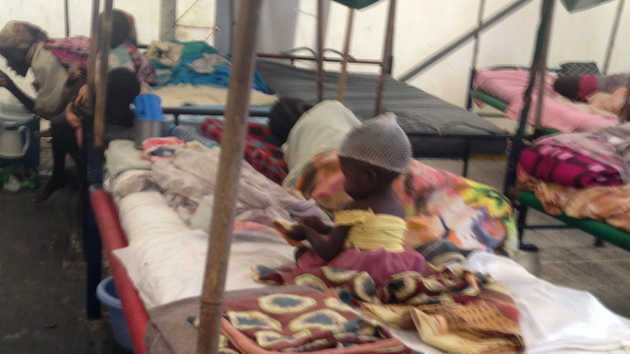
Of those who make it to the hospital in such a condition, 10% don’t survive, Javier Roldan, MSF’s medical team leader, tells me. “We have people who come in in later stages or have a co-infection because malnutrition has compromised their immune system, which makes treatment much more complicated.” He talks of the difficulty of losing patients for want of better facilities, more staff, and greater resources. “The outcome of a baby weighing one and a half kilos [3.3 pounds] in Europe or America would be no problem at all, but here there’s quite a high mortality rate,” says Roldan. “It’s very frustrating for the medical staff when you have patients die because you don’t have the means to treat them.”
And Malakal is no anomaly. At the MSF feeding station in Leer, a town in adjoining Unity State, they’ve treated roughly 1,800 malnourished children since mid-May, compared to 2,300 in all of last year. North of Leer, in Bentiu, the site of repeated spasms of violence, the situation is especially grim. “Over five percent of the children are suffering from severe acute malnutrition,” says CARE’s Country Director for South Sudan Aimee Ansari. “On the day I left Bentiu, CARE helped parents transport the bodies of children who had died from malnutrition to a burial site.” In all, according to the United Nations Children’s Fund (UNICEF) and the U.N. World Food Program (WFP), almost one million South Sudanese children under five years of age will require treatment for acute malnutrition in 2014. UNICEF projects that 50,000 of them could die.
The Camps and the Countryside
At the U.N.’s Tongping camp in Juba—where nearly 11,500 of the area’s tens of thousands of internally displaced persons are taking refuge—the food situation is “not very good at all.” So John, a 17-year-old resident, emphatically assures me beneath the relentless midday sun. “Outside, when I was living at home, we could have fruit or whatever we wanted.” Here, he eats no fresh food and no vegetables. Its sorghum and “the yellow food” mixed with sugar, oil, and water. “This food doesn’t even compare,” he says more than once.
Still, people here aren’t dying of malnutrition and even those in the ruder, more dismal camps in Bentiu and Malakal are luckier than most since they have access to aid from NGOs. At a time when South Sudan needs them most, however, almost eight months of war, insecurity, and attacks on aid workers have severely limited the reach of humanitarian organizations. Speaking of the entire NGO community, Wendy Taeuber, country director for the International Rescue Committee in South Sudan, says, “The remoteness of rural areas of South Sudan combined with the rainy season means that there are hundreds of thousands of IDPs still in need of additional assistance.”
Sitting in the trailer that serves as his office, I ask Paulin Nkwosseu, the chief field officer for UNICEF in Malakal, about the situation of those in less accessible areas along the Nile River where World Food Program distributions are limited. “Due to the crisis, people have no income and no food, so they’re surviving on monthly food distributions from WFP,” he tells me. “But they say that the food distributed by WFP is not sufficient for the whole family.”
UNICEF works with NGO partners to reach people outside the camps, but it’s a struggle. Nkwosseu walks over to a large wall map and begins to point out Nile River towns to the north like Wau Shilluk (currently suffering a cholera outbreak), Lul, Kodok, and Melut. These, he says, are hubs where South Sudanese from rural areas go when faced with hunger. The reason is simple enough: the river is one of the few viable transport options in a country the size of Texas that has almost no paved roads and whose dirt tracks in the rainy season are quickly reduced to impassable mud.
Even using the Nile is anything but a slam-dunk operation. Earlier this year, for instance, a convoy of barges transporting food and fuel to Malakal was attacked by armed men. Even absent the acts of rebels, soldiers, or bandits, food barges are regularly delayed by everything from mechanical issues to drawn out negotiations with local powerbrokers. Air drops are costly, impractical, and—thanks to a lack of airfield infrastructure—often unfeasible. Security is minimal and so thousands of tons of food stocks have simply been looted. Even when road transport is possible, vehicles are attacked and food is stolen by both government and rebel troops, eager to feed themselves. When food supplies do make it to the river towns, many in need are unlikely to make it in from the water-logged countryside in time.
America’s Limits
Among African nations, South Sudan has had an almost unprecedented relationship with the United States. Aside from Liberia—a nation settled, hundreds of years ago, by former American slaves, whose capital is named after a US president—it is the only African country for which Americans have evidenced a deep bipartisan commitment and “longstanding humanitarian and political interest as well as a deeper kinship,” says Cameron Hudson, who was the director for African affairs on the staff of the National Security Council from 2005 to 2009.
“For nearly a decade leading up to the 2011 declaration of independence, the cause of the nation and its citizens was one that was near and dear to the heart of two successive US administrations and some of its most seasoned and effective thinkers and policymakers,” Patricia Taft, a senior associate with the Fund for Peace, wrote in a recent analysis of South Sudan. “In order to secure this nation-building ‘win,’ both the George W. Bush and Obama administrations poured tons of aid into South Sudan, in every form imaginable. From military aid to food aid to the provision of technical expertise, America was South Sudan’s biggest ally and backer, ardently midwifing the country into nationhood by whatever means necessary.”
For all America’s efforts, the wheels started coming off almost immediately. “We’ve gotten pretty good at understanding what goes into building a state, institutionally, but as far as what creates a nation that’s actually functional, we fell short,” Taft tells TomDispatch. The US, she says, failed to do the necessary heavy lifting to encourage the building of a shared national identity and sat on its hands when targeted interventions might have helped reverse worrisome developments in South Sudan.
Still, the US repeatedly pledged unyielding support for the struggling young nation. In August 2012, for example, then-Secretary of State Hillary Clinton, speaking in Juba, was emphatic that the US “commitment to this new nation is enduring and absolute in terms of assistance and aid and support going forward.” A year later, announcing the appointment of Donald Booth as President Obama’s Special Envoy for Sudan and South Sudan, Clinton’s successor, John Kerry, made special reference to America’s “enduring commitment” to the South Sudanese people.
Lately, however, words like “enduring and absolute” have been replaced by the language of limits. Speaking in Juba just days before the July Christmas party, US Assistant Secretary of State for Population, Refugees, and Migration Anne Richard drew attention to the fact that the US had given generously to South Sudan, but that such assistance would be of little use if the war continues. “There is a limit to how much aid can be provided in a year with so many crises around the world,” she said.
That doesn’t bode well for those already going hungry and those who will be affected by the coming famine, forecast by some to be the worst since Ethiopia’s in the 1980s. Here, limits equal lives lost. A $1.8 billion U.N. aid operation designed to counter the immediate, life-threatening needs of the worst affected South Sudanese is currently just 50% funded, according to Amanda Weyler of the U.N. Office for the Coordination of Humanitarian Affairs in South Sudan. She explains that “any shortfall in funding potentially means that we cannot save lives of people that we may otherwise have been able to help.”
In a statement emailed to TomDispatch, Anne Richard acknowledged this very point, though she couched it in the language of “needs,” not lives. She put the blame on South Sudan’s warring factions while lamenting the plethora of crises around the world. “Even if Congress again funds our budget so that we can provide a solid share of support to aid organizations and U.N. appeals, we can’t cover them completely and other donor countries will also be stretched. At some point, we may see reports of food and water shortages and healthcare needs going unaddressed,” she wrote. “Ultimately, these crises are man-made and will not be alleviated until the fighting stops.”
Do They Know It’s Christmastime At All?
It’s an overcast day, but the sun is strong behind the clouds and it’s bright inside the white tent of the Médecins Sans Frontières field hospital. It’s also hot. One of several large, aged metal fans pushes the heavy, humid air around these cramped quarters as the staff moves purposefully from patient to patient, checking progress, dispensing medicine, providing instructions. Children cry and shriek, babble and laugh, and cough and cough and cough.
A scrawny black and white cat slips through a maze of legs moving from the rudimentary pharmacy to the examination room past the bed where Nyajuma sits. She’s putting on weight, 2.5 pounds since her arrival and so, for her, things are looking somewhat better. But as the country plunges into famine, how many other Nyajumas will arrive here and find there’s not enough food, not enough medicine, too few doctors? How many others will never make it and simply die in the bush?
“When there’s a clash, when the conflict starts, it’s in the news every day. Then we start to forget about it. In South Sudan, the needs are only getting bigger, even bigger than in the beginning,” MSF’s Javier Roldan tells me. “When the conflict becomes chronic, the situation deteriorates. Food access is getting even more difficult. Fewer donors are providing money, so the situation for civilians is deteriorating day by day.”
That embassy party in Juba seems light years away, not just in another state but another world—a world where things in Malakal don’t seem so bad. It’s a world where choice cuts of beef sizzle and cold lager flows and the pool looks cool and inviting, a world where limits on aid are hard realities to be dispassionately explained and cursorily lamented, not death sentences to be suffered.
From Iraq to Afghanistan, American-style nation building has crumbled, exposing the limits of American power. Before things are over in South Sudan, Washington’s great experiment in Africa may prove to be the most disastrous effort of all. Just three years after this country’s independence, two years after Hillary Clinton stood in this city and pledged enduring and absolute assistance, at a time when its people are most in need, the US is talking about limits on aid, about backing away from the country it fostered, its prime example of nation-building-in-action in the heart of Africa. The effects will be felt from Juba to Jonglei, Bor to Bentiu, Malek to Malakal.
If things continue as they have, by the time the US Embassy throws its actual Christmas bash, the civil war in South Sudan will have entered its second year and large swaths of the country might be months into a man-made famine abetted by an under-funded humanitarian response—and it’s the most vulnerable, like Nyajuma, who will bear the brunt of the crisis. Experts are currently debating if—or when—famine can be declared. Doing so will exert additional pressure on funders and no doubt save lives, so a declaration can’t come fast enough for Kate Donovan of UNICEF in South Sudan. “Waiting for data to be crunched in order to make sure all the numbers add up to famine is deadly for small children,” she says. “It is like ringing fire alarms when the building is already burnt to the ground.”
If history is any guide and projections of 50,000 child malnutrition fatalities are accurate, the outlook for South Sudan is devastating. What Donovan tells me should make Washington—and the rest of the world—sit up and take notice: “Half the kids may already be dead by the time famine is actually declared.”
Nick Turse is the managing editor of TomDispatch.com and a fellow at the Nation Institute. A 2014 Izzy Award winner, he has reported from the Middle East, Asia, and Africa and his pieces have appeared in the New York Times, the Los Angeles Times, the Nation, and regularly at TomDispatch. He is the author most recently of the New York Times bestseller Kill Anything That Moves: The Real American War in Vietnam. This story is the second in a series of on-the-ground reports from Africa pursued in partnership with the Investigative Fund at the Nation Institute. Additional funding was provided through the generosity of Adelaide Gomer. To stay on top of important articles like these, sign up to receive the latest updates from TomDispatch.com here.
